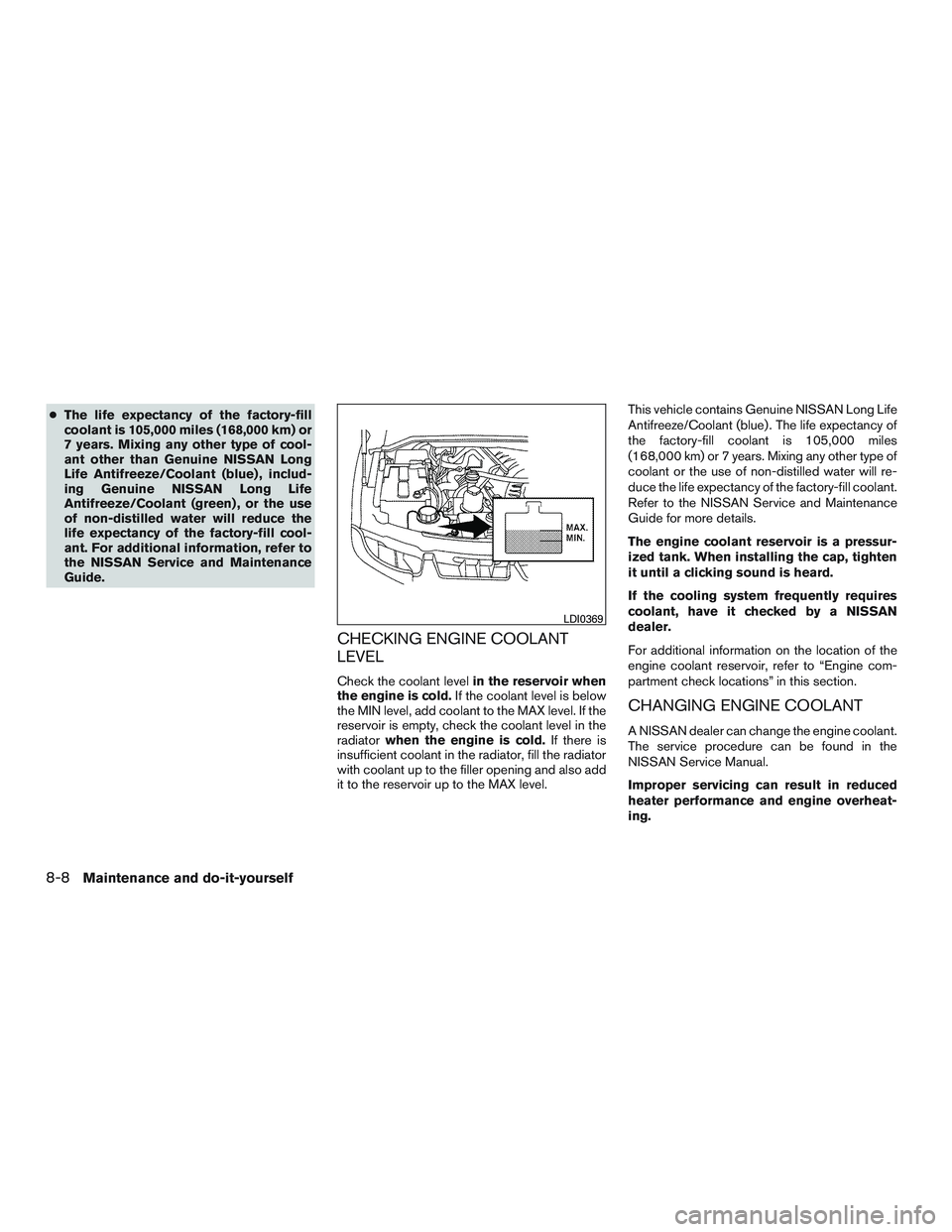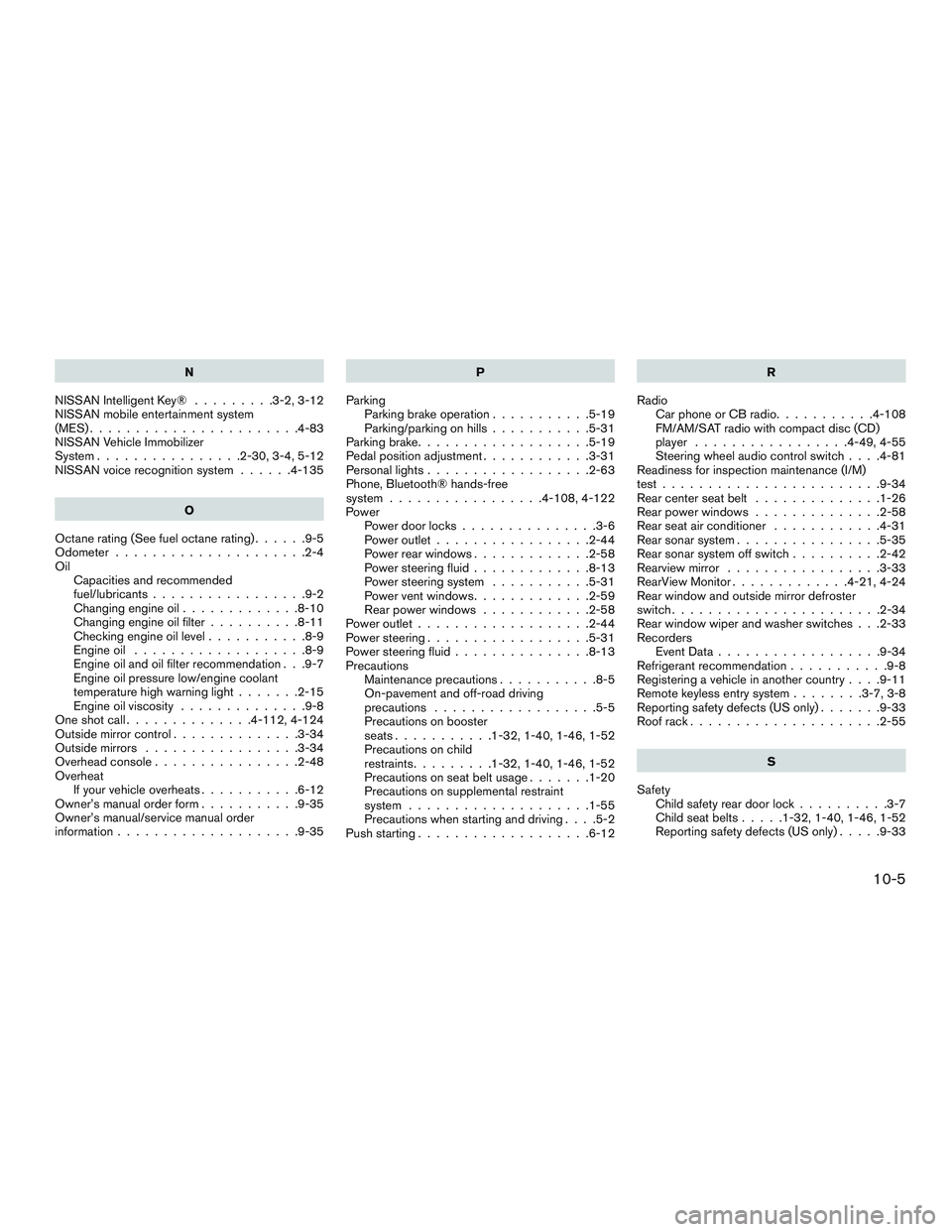Page 101 of 510
CAUTION
If the gauge indicates coolant tempera-
ture near the hot (H) end of the normal
range, reduce vehicle speed to decrease
temperature. If the gauge is over the nor-
mal range, stop the vehicle as soon as
safely possible. If the engine is over-
heated, continued operation of the vehicle
may seriously damage the engine. For ad-
ditional information, refer to “If your ve-
hicle overheats” in the “In case of emer-
gency” section of this manual for
immediate action required.
FUEL GAUGE
The gauge indicates theapproximatefuel level
in the tank.
The gauge may move slightly during braking,
turning, acceleration, or going up or down hills.
The gauge needle returns to E (Empty) after the
ignition key is turned to OFF.
The low fuel warning light comes on when the
amount of fuel in the tank is getting low.
Refill the fuel tank before the gauge regis-
ters E (Empty) . The
Page 140 of 510

●Only certain power outlets are designed
for use with a cigarette lighter unit. Do
not use any other power outlet for an
accessory lighter. See a NISSAN dealer
for additional information.
● Do not use with accessories that exceed
a 12 volt, 120W (10A) power draw.
● Do not use double adapters or more
than one electrical accessory.
● Use power outlets with the engine run-
ning to avoid discharging the vehicle
battery.
● Avoid using power outlets when the air
conditioner, headlights or rear window
defroster is on.
● Before inserting or disconnecting a
plug, be sure the electrical accessory
being used is turned OFF.
● Push the plug in as far as it will go. If
good contact is not made, the plug may
overheat or the internal temperature
fuse may open.
● When not in use, be sure to close the
cap. Do not allow water or any other
liquid to contact the outlet.
MAP POCKETS SEATBACK POCKET
The seatback pocket is located on the back of the
driver seat. The pocket can be used to store
maps.
Page 368 of 510
WARNING
Overheating can result in reduced engine
power and vehicle speed. The reduced
speed may be lower than other traffic,
which could increase the chance of a col-
lision. Be especially careful when driving.
If the vehicle cannot maintain a safe driv-
ing speed, pull to the side of the road in a
safe area. Allow the engine to cool and
return to normal operation. For additional
information, refer to “If your vehicle over-
heats” in the “In case of emergency” sec-
tion of this manual.
Page 423 of 510

●The life expectancy of the factory-fill
coolant is 105,000 miles (168,000 km) or
7 years. Mixing any other type of cool-
ant other than Genuine NISSAN Long
Life Antifreeze/Coolant (blue) , includ-
ing Genuine NISSAN Long Life
Antifreeze/Coolant (green) , or the use
of non-distilled water will reduce the
life expectancy of the factory-fill cool-
ant. For additional information, refer to
the NISSAN Service and Maintenance
Guide.
CHECKING ENGINE COOLANT
LEVEL
Check the coolant level in the reservoir when
the engine is cold. If the coolant level is below
the MIN level, add coolant to the MAX level. If the
reservoir is empty, check the coolant level in the
radiator when the engine is cold. If there is
insufficient coolant in the radiator, fill the radiator
with coolant up to the filler opening and also add
it to the reservoir up to the MAX level. This vehicle contains Genuine NISSAN Long Life
Antifreeze/Coolant (blue) . The life expectancy of
the factory-fill coolant is 105,000 miles
(168,000 km) or 7 years. Mixing any other type of
coolant or the use of non-distilled water will re-
duce the life expectancy of the factory-fill coolant.
Refer to the NISSAN Service and Maintenance
Guide for more details.
The engine coolant reservoir is a pressur-
ized tank. When installing the cap, tighten
it until a clicking sound is heard.
If the cooling system frequently requires
coolant, have it checked by a NISSAN
dealer.
For additional information on the location of the
engine coolant reservoir, refer to “Engine com-
partment check locations” in this section.
CHANGING ENGINE COOLANT
A NISSAN dealer can change the engine coolant.
The service procedure can be found in the
NISSAN Service Manual.
Improper servicing can result in reduced
heater performance and engine overheat-
ing.
Page 483 of 510
Temperature conditions can also affect towing.
For example, towing a heavy trailer in high outside
temperatures on graded roads can affect engine
performance and cause overheating. The engine
protection mode, which helps reduce the chance
of engine damage, could activate and automati-
cally decrease engine power. Vehicle speed may
decrease under high load. Plan your trip carefully
to account for trailer and vehicle load, weather
and road conditions.
Page 504 of 510

N
NISSAN Intelligent Key® .........3-2,3-12
NISSAN mobile entertainment system
(MES) .......................4-83
NISSAN Vehicle Immobilizer
System ................2-30,3-4,5-12
NISSAN voice recognition system ......4-135
O
Octanerating(Seefueloctanerating)......9-5
Odometer .....................2-4
Oil Capacities and recommended
fuel/lubricants .................9-2
Changing engine oil .............8-10
Changing engine oil filter ..........8-11
Checking engine oil level ...........8-9
Engine oil ...................8-9
Engine oil and oil filter recommendation . . .9-7
Engine oil pressure low/engine coolant
temperature high warning light .......2-15
Engine oil viscosity ..............9-8
Oneshotcall..............4- 112, 4-124
Outside mirror control ..............3-34
Outside mirrors .................3-34
Overhead console ................2-48
Overheat Ifyourvehicleoverheats...........6-12
Owner’s manual order form ...........9-35
Owner’s manual/service manual order
information ....................9-35 P
Parking Parking brake operation ...........5-19
Parking/parking on hills ...........5-31
Parking brake ...................5-19
Pedal position adjustment ............3-31
Personallights..................2-63
Phone, Bluetooth® hands-free
system .................4- 108, 4-122
Power Power door locks ...............3-6
Power outlet .................2-44
Power rear windows .............2-58
Power steering fluid .............8-13
Power steering system ...........5-31
Power vent windows .............2-59
Rear power windows ............2-58
Power outlet ...................2-44
Power steering ..................5-31
Power steering fluid ...............8-13
Precautions Maintenance precautions ...........8-5
On-pavement and off-road driving
precautions ..................5-5
Precautions on booster
seats...........1-32,1-40,1-46,1-52
Precautions on child
restraints .........1-32,1-40,1-46,1-52
Precautions on seat belt usage .......1-20
Precautions on supplemental restraint
system ....................1-55
Precautions when starting and driving ....5-2
Push starting ...................6-12 R
Radio CarphoneorCBradio...........4-108
FM/AM/SAT radio with compact disc (CD)
player .................4-49,4-55
Steering wheel audio control switch . . . .4-81
Readiness for inspection maintenance (I/M)
test ........................9-34
Rear center seat belt ..............1-26
Rear power windows ..............
2-58
Rear seat air conditioner ............4-31
Rear sonar system ................5-35
Rear sonar system off switch ..........2-42
Rearview mirror .................3-33
RearView Monitor .............4-21,4-24
Rear window and outside mirror defroster
switch.......................2-34
Rear window wiper and washer switches . . .2-33
Recorders EventData..................9-34
Refrigerant recommendation ...........9-8
Registering a vehicle in another country ....9-11
Remote keyless entry system ........3-7,3-8
Reporting safety defects (US only) .......9-33
Roof rack .....................2-55
S
Safety Child safety rear door lock ..........3-7
Child seat belts .....1-32,1-40,1-46,1-52
Reporting safety defects (US only) .....9-33
10-5